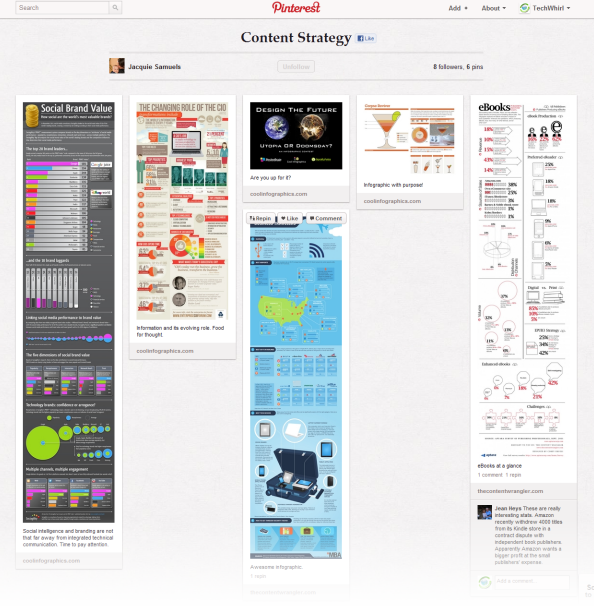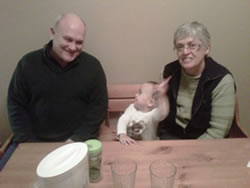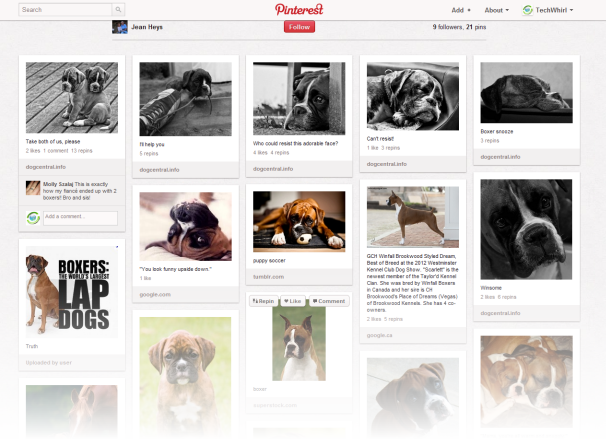I was talking with my mother last week, and she mentioned that she’s enjoying gathering and sharing pictures of boxer puppies on Pinterest. I said “On what?” I had no idea what she was talking about. It’s not often that my mother gets the jump on me in the internet realm, but she certainly did this time. So I looked into it. Being a content strategist with more than a passing interest in technical communications, I’m afraid I looked at it from a somewhat unique point of view. The result? This article. (Thanks, Mom!)
Social media is moving forward again, by leaps and bounds, this time with Pinterest, a site that lets you collect or “pin” graphics that interest you (from anywhere online or from your own stash of graphics). You pin graphics to your “boards,” which are just a way of organizing those graphics in a way that makes sense to you. Other people can follow what you pin, repin something they find interests them, or comment on what you have pinned. It’s one of the largest, fastest growing social sites (see Bonsiri Dickenson’s Business Insider article for instance) of 2011 and 2012. So what’s the big deal?
You can:
- Find other people who share the same interests as you
- Group media logically, publicly, and with a particular purpose (like wedding planning)
- Build a following of your own
- Express yourself through aggregating other people’s media
Great, another way to avoid working. Or is that all it is? At this point you may be asking yourself how the worlds of Pinterest and technical communications collide. At first glance, the answer might appear to be “they don’t.” Pinterest looks fun and it’s most definitely a way of communicating your style and interests to other people, but gathering media into collections isn’t typically something our end users need to do.
Pinterest in Technical Communications? Get Real
I can’t believe I’m saying this, but there are actually practical applications of what people are doing with Pinterest to technical communications. Yes, OK, I said it and the world only wobbled a little.
Here are some thoughts on why technical communications needs to pay attention to Pinterest:
- People like to gather and organize information assets in a way that’s meaningful to them. They like to share the results with other people and have people comment on or follow what they’re doing.
- Ownership of the asset is a moot point. People are merely organizing/tagging content that exists out there somewhere. It’s not theirs (necessarily) and they’re not claiming ownership by pinning them. It’s a method of aggregation (and sharing that aggregation) only.
- People like to build communities around a shared understanding of something, whether it’s a certain style, a love of puppies, great photographs, or (wait for it) content that can help them get their work done in faster, more efficient, or more innovative ways. Can you see where I’m going with this?
- Our end users are people too.
So imagine, if you will, a library of content from a set of products that people use in coordination, maybe even from more than one company (oh, to dream). That content is made up of topics, videos, graphics, books, whitepapers, wiki content, and anything else we can dream up.
Instead of people just browsing through content (hopefully with a very powerful search engine) and pouring over PDFs, when they find something that’s useful to them, they pin it to their own board. They collect the information that makes sense for what they’re doing. They might even add their own content. They browse other users’ boards to see how they’ve organized things, even using that as a shortcut to build their own boards. And the users who do a lot of pinning start gathering a following. They become super users and super collaborators. And all this by simply collecting content, organizing it, and tagging it a very basic way.
The result:
- People actually use and read your technical content (hot damn!) in ways you may not have even anticipated (that’s OK, learn from it).
- You start to understand complex use cases of how they’re working, what products and features they’re using together, what use case they have, and even what gaps exist.
- You promote user collaboration in a way that doesn’t affect source content (they’re not changing or owning the content they’re finding and aggregating, so you don’t have to manage traditional collaboration or intellectual property problems).
- You build a community of users who work together (and with you) to create a user experience of information asset sharing that will be totally awesome.
- You get a really great head start on creating a metadata schema for your content (your users are tagging for you!).
- Your users can build their own libraries of content in a way that is useful and meaningful to them (and others like them). Sure, you’re making them do the work, but it looks like they actually enjoy it (see the booming rate of interest in Pinterest).
- You get metrics like you’ve never seen before to help you plan future versions of technical communication products, letting you see where you need to go more in-depth, provide a video tutorial, and even get rid of content that is too basic (ahem, please build that into the interface).
And, I just have to mention this because this is the greatest part, you can apply this whole paradigm internally as well. Authors can tag and group content, media, SharePoint sites, tidbits of information that will help them work faster and more efficiently. Create storyboards for new multi-media projects easily, graphically (and later make the final projects available for pinning)!
And why stop there? Apply it to the whole intranet, companywide, and let people work in a way that is both customized to them and collaborative with the rest of the company. (Try out my content strategy Pinterest board for starters.)

My Pinterest board on Content Strategy features good infographics I’ve found that could be useful for technical communications. Feel free to comment and repin.

Jean Heys, My Mom, Pinterest SME and Article Inspiration
Like every hot new technology that technical communicators want to get their teeth into, Pinterest the tech comm tool has some obvious technical hurdles to clear (like building the capability of gathering more than just graphics); some best practices to carefully implement; and a massive amount of planning to accomplish. But take from Pinterest the most important lesson: This is how people like to manage their content (whether it be just graphics or a lot more)… and people, it turns out, are our users.
The technical communications possibilities, as I see them, are endless. So thanks again, Mom. Those puppies are really cute.
